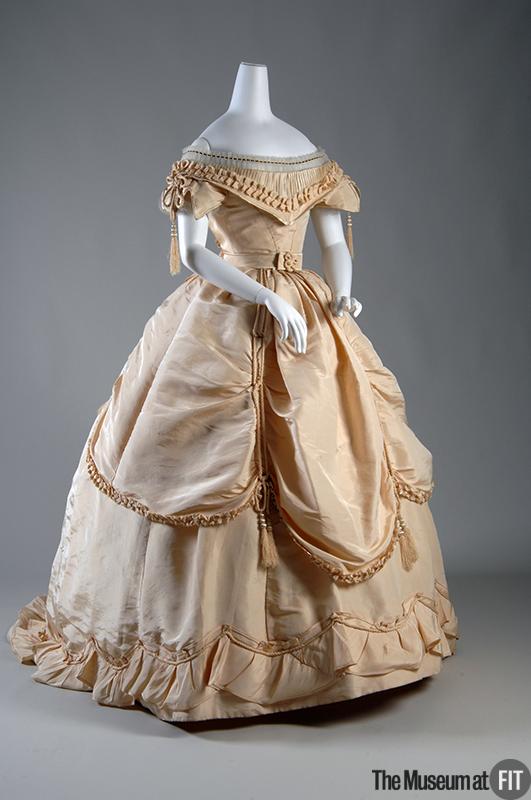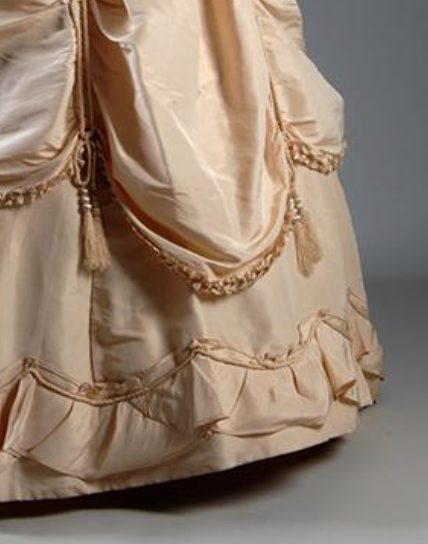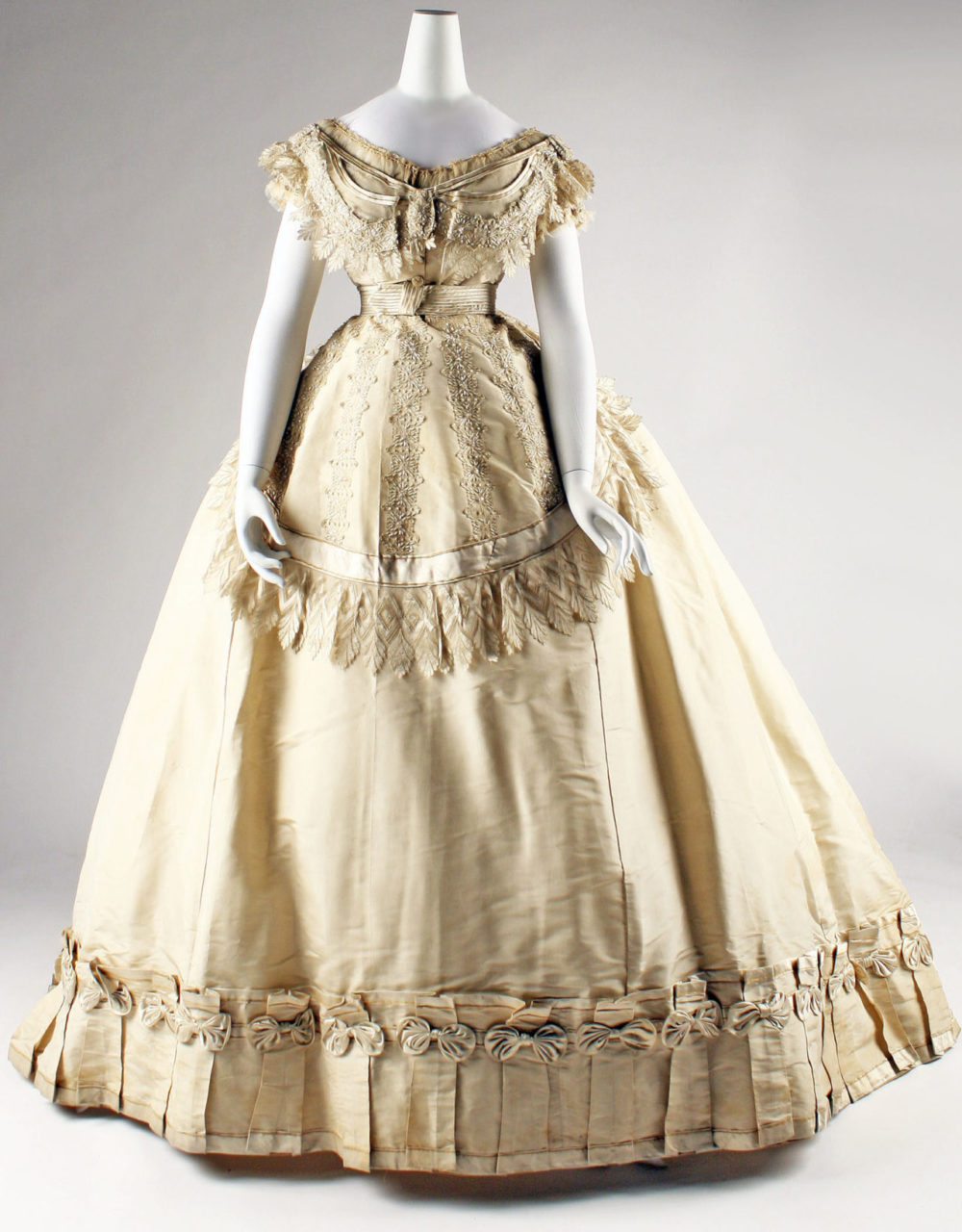This charming 1865 cream silk taffeta dress features many design details of fashionable evening looks of the time, like a defined waist and passementerie.
About the Look
This 1865 evening dress features an off-the-shoulder neckline, with a fitted waistline and full crinolined skirt. The detailed neckline includes layers of thin black and light blue ribbons, jewelry pleated silk and a box-pleat trim finished in a V-neckline. From the neckline, there are two taffeta bows trimmed with passementerie and a single beaded tassel. The bodice is draped with irregular princess darts meeting just off of center front. At the waistline, a thin two-inch belt lays with a frog as its closure in center front. The large ballgown skirt is overlaid with large petal-like drapes (a form of a polonaise) and two dangling tassels. The large petals are gathered at the waist and they are trimmed with horizontal knife pleats (Fig. 1). The skirt is finished with cascading ruffles and a cording trim.
Fig. 1 - Designer unknown (Scotland). Dress detail, 1865. Cream silk taffeta, satin, tulle, cording and tassels and black ribbon. New York: The Museum at FIT, 75.227.41. Gift of Mildred R. Mottahedeh. Source: The Museum at FIT
Dress, 1865. Cream silk taffeta, satin, tulle, cording and tassels and black ribbon. New York: The Museum at FIT, 75.227.41. Image: Museum at FIT

About the context
T
his 1865 cream silk taffeta evening dress was a fashionable look of its time. In comparison to other 1860s gowns, it carries the same elegance, as well as various design details such as passementerie, and a fitted waist line. As the Museum at FIT states:
“Bare shoulders were typical of 1860s evening gowns, as in this sumptuously adorned example. Full skirts created the illusion of a narrow waist. Cage crinolines had replaced layers of petticoats as the way to maintain a skirt’s fullness, and many women (as well as men) enjoyed the flirtatious, ankle-revealing swing of a crinoline.”
As seen in all of the figures here, off-the-shoulder gowns were a popular neckline in the 1860s. In a March 1865 fashion plate from Le Follet (Fig. 2), we see three women all wearing similar off-shoulder evening dresses with looped up overskirts. An earlier Le Follet bridal fashion plate also features dresses with the same silhouette of the above gowns (Fig. 3).
Fig. 2 - Artist unknown (French). Le Follet, March 1865. Source: Pinterest
Fig. 3 - Artist unknown (French). Le Follet, March 1863. Source: Pinterest
Fig. 4 - Designer unknown (American). Wedding dress, 1869. Silk. New York: The Metropolitan Museum of Art, C.I.67.45.1a–c. Gift of Catharine M. Hitchcock. Source: The Metropolitan Museum of Art
Fig. 5 - Designer unknown (French). Silk dress, ca. 1867. Silk. New York: The Metropolitan Museum of Art, C.I.45.68.8a–c. Gift of Art Worker's Club. Source: The Metropolitan Museum of Art
Fig. 6 - Designer unknown (American). Wedding dress, 1867. London: Victoria and Albert Museum, T.37&A-1951. Given by Mrs Campbell. Source: V&A
Fig. 7 - Emile Pingat (French, active 1860–96). Silk ballgown, ca. 1860. Silk. New York: The Metropolitan Museum of Art, C.I.69.33.1a, b. Gift of Mary Pierrepont Beckwith. Source: The Metropolitan Museum of Art
The cream silk dresses in figures 4-6 all define the waist with an added belt as the Museum at FIT dress does. While figure 4 is quite plain, figures 5-7 show an equivalent enthusiasm for decorative accent. In the 1865 cream taffeta evening dress, the neckline and petal drapes are accented with passementerie and Le Follet describes this trend eloquently:
“Passementerie, as we last month prophesied, will be the trimming par excellence. The Figure épaulette of passementerie, terminating in a fringe, is very graceful and becoming, and just now much adopted.” (2)
Passementerie and fringe were commonly used as an embellishment or accent to an evening gown. They were used in the same fabric as the gown, preferably silk, or in an contrasting color for style.
In the 1860s, full skirts were very fashionable and women began raising up outer layers of their skirts to reveal their skirts in different manners. In Frank Leslie’s Lady’s Magazine they describe this trend:
“The styles of looping skirts differ essentially. Gimp is found to be too heavy at this season of the year, so it has given place to cross-out bands of silk, which descend every breadth of the skirt as far as the knee. At the knee they form either a circle or a bow, which continues in a double band, and the skirt is looped up by means of these.” (19)
As seen in figure 7, the full skirt is accented with petal-like drapes that are accomplished using similar methods described in Frank Leslie’s Lady’s Magazine. The skirt is picked up at the knee and is finished with tassels.
The 1865 cream taffeta evening dress was a very fashionable evening dress for the 1860s. The garment’s full skirt, passementerie accents, trims and neckline all fall into major fashion trends of that time. The 1865 evening dress is a classic look and has remained an inspiration for all decades since.
References:
- “Dress.” Museum at FIT. Accessed March 29, 2016. http://fashionmuseum.fitnyc.edu/view/objects/asitem/search$0040/0?t:state:flow=cc464faa-ad76-409d-9a06-1761aec7d01d
- “La Mode.” Le Follet 17 (March 1863). https://books.google.com/books?id=dh0GAAAAQAAJ&printsec=frontcover&source=gbs_ge_summary_r&cad=0#v=onepage&q&f=false
- “Lady’s Magazine.” Frank Leslie’s Lady’s Magazine 17 (July 1865). https://babel.hathitrust.org/cgi/pt?id=nyp.33433103958397;view=1up;seq=7

















